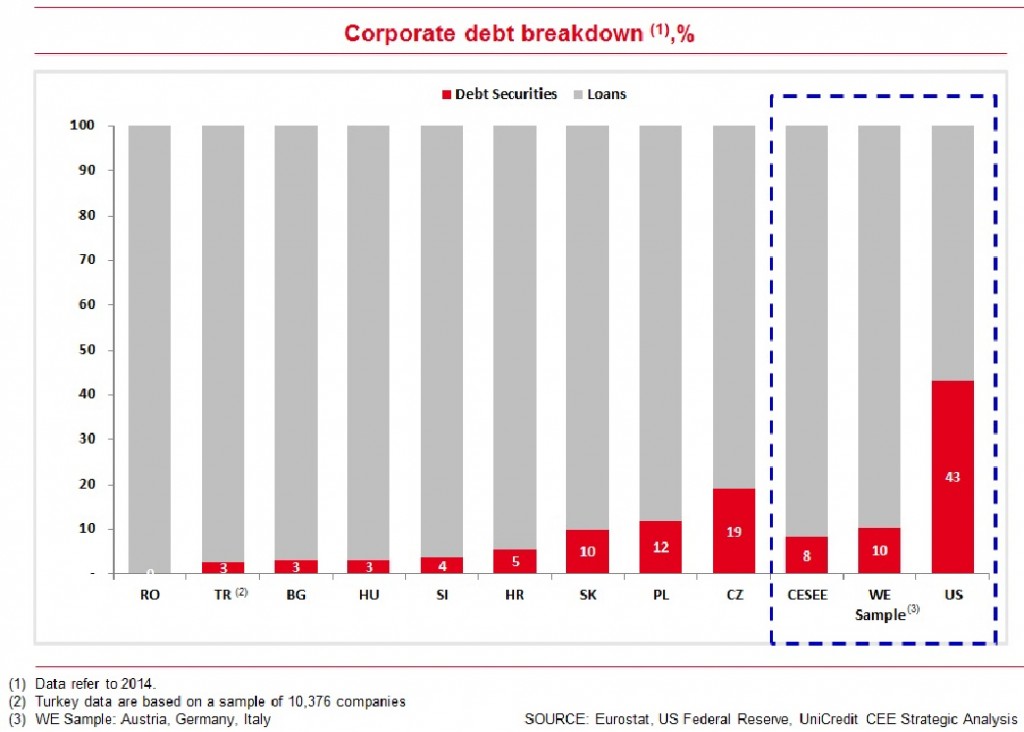Corporate lending remains a central area of banks´ business in the region, a moderate recovery expected going forward while the structure of corporates’ sources of financing in CEE indicates a potentially greater role for debt securities
Corporate lending is going to remain a central area of banks´ business in Central and Eastern Europe (CEE[1]) and it is expected to recover moderately going forward. This is one of the key findings of the recent “Banking in CEE – Supporting Sustainable Growth and Innovation” study compiled by CEE Strategic Analysis at UniCredit. Although corporate lending has been weak in most CESEE[2] countries in the past years, which appears to be related to lower investments and, in part, to higher corporate savings, corporate loans growth has accelerated in some countries in 2015. At the same time the structure of corporates’ sources of financing in CEE indicates that there is scope for a potentially greater role for debt securities. Exports and EU funds should provide additional business opportunities for banks in the region.
“The economic environment, in which banks are operating in Central and Eastern Europe, is expected to remain overall positive. Most countries in the region will show solid economic growth in both, 2016 and 2017”, said Carlo Vivaldi, Head of CEE Division at UniCredit. According to UniCredit Research real GDP growth of CESEE should reach 3.2 per cent this year and 3.3 per cent next year following 3.5 percent in 2015, the respective rates of CEE will be 1.3 per cent and 2.6 per cent following 0.4 per cent last year. Moreover economic growth is expected to spread to all CEE countries in 2016.“Following the global financial crisis in 2008, the corporate financing gap in CESEE has turned positive reflecting low financing needs due to lower investments and, in part, higher savings ”, stated Mauro Giorgio Marrano, Deputy Head of CEE Strategic Analysis at UniCredit. For example gross corporate savings as a portion of GDP climbed to 20.2 per cent on average in Bulgaria in the 2009 – 2014 period compared to 15.5 per cent between 2004 and 2008, and to 17.6 per cent on average in Hungary compared to previously 14.1 per cent. Although not all CESEE countries have shown an increase in corporate gross savings, the reduction in investment has been observable across the board. As the economic recovery progresses, corporate lending is expected to pick up with the regional laggards improving.
While lending is going to remain the main source of corporate financing in CEE, there is scope for a potentially greater role of debt securities. “Over the past years, we have seen that the share of financing through debt securities has increased somewhat in countries such as Czech Republic, Poland and Slovakia. Nevertheless its share is still low in most countries”, noted Carlo Vivaldi. On average the share of debt securities in total corporate financing amounts to 8 per cent in CESEE, but it is 10 per cent in Western Europe and 43 per cent in the US. Czech Republic, Poland and Slovakia are already above CESEE average.
Further business opportunities for banks´ corporate business may be initialized by growing exports and an improving absorption of EU funds. Exports represent a significant portion of GDP in most CEE countries exceeding euro area and global average. With the euro area being the most important trading partner of the region, exports should record solid growth rates above the global average in most CEE countries in 2016 and 2017.
EU Funds are an important source of financing CEE-EU[3] economies, with banks providing advisory services, co-financing and financial intermediation. For the current programming period 2014 – 2020, more than EUR 200 billion has been allocated by the European Commission under the European Structural and Investment Funds for the CEE member states. Approximately EUR 117 billion is allocated to six CEE countries, being Bulgaria, the Czech Republic, Croatia, Hungary, Romania and Slovakia. Out of this, 20 per cent or EUR 23 billion, are meant to finance the private sector, where banks are mostly involved. “Around EUR 3.5 billion will be implemented through facilities approved by UniCredit”, estimated Carlo Vivaldi, Head of CEE Division at UniCredit.
UniCredit re-invests EUR 13 billion in organic growth of CEE business
UniCredit considers itself a long-term, strategic investor in Central and Eastern Europe, which is keen to develop its business with both corporate and private customers in the region. Since 2007 CEE Division re-invested a total of EUR 13 billion in profit before tax in the region.
In 2015 the banking group has acquired over 1.2 million new customers across all CEE countries, where it has a presence, and it intends to grow its customer base by another 1 million customers each year until 2018. Over the same period CEE CIB aims at increasing its number of customers by approximately 10,000 corporations annually. According to its Strategic Plan UniCredit is going to invest EUR 1.2 billion into digitalization aiming equally at matching new trends in customer behaviour and reducing costs. The number of internet banking users is projected to increase from currently 5 million to 10 million and the number of mobile banking users from currently 1 million to 7 million over the next three years. CEE lending volume is expected to grow by EUR 20 billion to EUR 106 billion in 2018.
“We are fully committed to the new Strategic Plan and its implementation is fully on track, including the intended transfer of CEE shareholdings from Vienna to Milan by year-end 2016. With this step, we lay the foundation for an even leaner governance structure and a more effective capital and liquidity management within the Group”, emphasized Carlo Vivaldi.
UniCredit is the banking group number one in Central and Eastern Europe – in terms of network, total assets and geographic diversification. The banking group operates an extensive network of roughly 3,000 branches in 13 countries, which generates roughly one quarter of its total revenues. UniCredit in CEE serves more than 26,000 international corporate customers. 2 out of 3 international corporate customers from Germany, Italy and Austria operating in CEE are served by UniCredit´s International Centers. The banking group has a long-established expertise in handling state and EU-supported programs in the CEE region resulting in more than EUR 2 billion facilities dedicated to EU Funds projects approved and another over EUR 1.3 billion agreements signed with the European Investment Fund in the first programming period 2007 – 2013. By this, UniCredit supported more than 8,000 CEE companies, mainly SMEs with EU funds and financial instruments.
UniCredit
UniCredit is one of Europe’s leading commercial banks with strong roots in 16 European countries. Our network, which is present in roughly 50 markets, includes over 7,000 branches and over 125,000 FTEs (as of December 31, 2015).
In the CEE region, the Group operates a large international banking network with more than 3,000 branches (incl. Turkey at equity).
UniCredit operates in the following countries: Austria, Azerbaijan, Bosnia and Herzegovina, Bulgaria, Croatia, the Czech Republic, Germany, Hungary, Italy, Poland, Romania, Russia, Serbia, Slovakia, Slovenia and Turkey.
Enquiries: UniCredit Media Relations International
Tiemon Kiesenhofer, Tel.: +43 (0) 50505 56036
Email: [email protected]
[1] CEE includes Bosnia, Bulgaria, Croatia, Czech Republic, Hungary, Poland, Romania, Russia, Serbia, Slovakia, Slovenia, Turkey and Ukraine.
[2] Central Europe and South Eastern Europe (CESEE) is CEE excluding Russia, Turkey and Ukraine.
[3] This group includes some of the countries that joined the EU in 2004 and 2007, namely Bulgaria, Croatia, the Czech Republic, Hungary, Poland, Romania and Slovakia.



